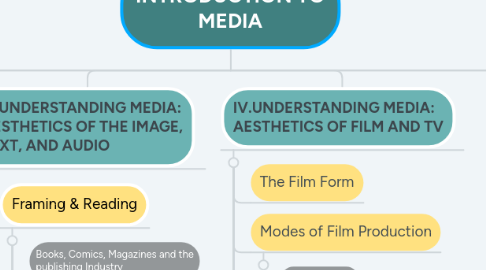
1. I.WHAT IS MEDIA?
1.1. Kinds of Media
1.1.1. Traditional Media
1.1.2. New Media
1.1.3. Social Media
1.1.4. Mobile Communication Technology
1.1.5. Related & Emerging Technologies
1.2. The Communication Process
1.2.1. Sender
1.2.2. Message
1.2.3. Channels
1.2.4. Reciever
1.3. Media as an Information Industry
1.3.1. Film Industry
1.3.2. Broadcast Industry
1.3.3. Publishing Industry
1.3.4. Photography Industry
1.4. The Feedback Mechanism
1.5. Media as a Culture of Entertainment
2. III.UNDERSTANDING MEDIA: AESTHETICS OF THE IMAGE, TEXT, AND AUDIO
2.1. Framing & Reading
2.1.1. Books, Comics, Magazines and the publishing Industry
2.1.2. Photography and Timeless images Concept
2.1.3. Newspaper & Journalism
2.2. Framing & Listening
2.2.1. Radio and Evoking Imagination
3. II.MEDIA THEN AND NOW
3.1. Brief History of Media
3.1.1. Pre-Industrial Age
3.1.2. Industrial Age
3.1.3. Electronic Age
3.1.4. Digital Age
3.2. Brief History of Philippine Media
3.2.1. Pre-colonial Traces
3.2.2. The Print Industry & Filipino Freedom
3.2.3. The European Film Import
3.2.4. The Broadcast Industry
3.2.5. Local Online Media
3.3. The State of Media Today
3.3.1. From Globalization to Glocalization
3.3.2. The Local Landscape
3.4. Media Ownership
3.4.1. Mainstream Media
3.4.2. Alternative & Independent Media
3.4.3. Community Media
3.4.4. State-owned Media
4. IV.UNDERSTANDING MEDIA: AESTHETICS OF FILM AND TV
4.1. The Film Form
4.2. Modes of Film Production
4.2.1. Preproduction
4.2.2. Production
4.2.3. Postproduction
4.3. Film Formats
4.3.1. Narrative
4.3.2. Documentary
4.3.3. Animation
4.3.4. Experimental
4.4. Film Image Composition
4.4.1. Relationship of objects & people
4.4.2. Play of light & dark
4.4.3. Color and their Patterns
4.4.4. Position of the camera & Angles used to frame the subjects
4.5. The TV Broadcst
4.5.1. Kinds of TV Shows
4.5.1.1. Informative Programming
4.5.1.2. Entertainment Programming
4.6. TV Show Anatomy & Advertising
4.6.1. Commercial Break
4.6.2. Commercial Gap
4.7. Crafting Media Messages
4.8. Creating Meaning in Audio Production
4.8.1. Audiovisual Production
4.8.1.1. Sounds
4.8.1.2. Music
4.8.1.3. Noise
4.8.1.4. Dialogue
5. V.UNDERSTANDING MEDIA: AESTHETICS OF NEW MEDIA & SOCIAL MEDIA
5.1. Deconstructing New Media
5.1.1. New Media as Multimedia
5.1.2. What is Social Networking?
5.1.3. Transitioning Media, Transitioning Users
5.2. Deconstructing Social Media
5.3. Intersecting Traditional Media, New Media, and Social Media Networking
5.3.1. journalism + Internet = Blogging
5.3.2. Broadcasting + Internet = Podcast
5.3.3. Film + Internet = Youtube
5.4. Transitioning Media, Transitioning Users
5.4.1. Types of Audiences
5.4.1.1. Digital native
5.4.1.2. Digital immigrant
6. VI.AESTHETICS OF SOCIAL NETWORKING
6.1. Kinds of Social Media & Its Varying Uses
6.1.1. Print based
6.1.2. Audio based
6.1.3. Photo based
6.1.4. Video based
6.1.5. Social networking sites
6.2. Relevance of Social Media in Today's Society
6.2.1. Personal Communications
6.2.2. Business & Customer Care Tools
6.2.3. Social Services & Governance
6.2.4. Educational Tools
6.2.5. Advocacy Campaigns for Social Change
6.2.6. Traditional Media Coverage & Social Media Enhancement
6.2.7. Entertainment Portals
